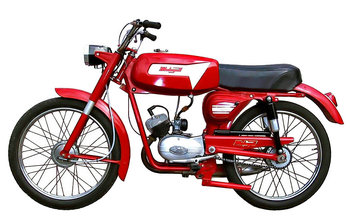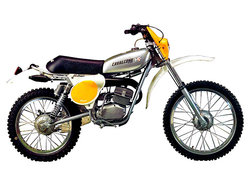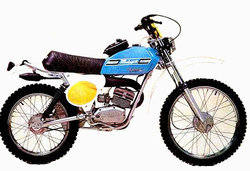Difference between revisions of "Malaguti"
m |
|||
| (3 intermediate revisions by the same user not shown) | |||
| Line 48: | Line 48: | ||
image:Mal1 001.jpg|<font color=>'''Malaguti Motorik Junior''' | image:Mal1 001.jpg|<font color=>'''Malaguti Motorik Junior''' | ||
Image:mal2 001.jpg|<font color=>'''Malaguti Mon Ami''' | Image:mal2 001.jpg|<font color=>'''Malaguti Mon Ami''' | ||
| + | </gallery> | ||
| + | |||
| + | <gallery> | ||
| + | File:Ronco 21 (161).jpg|'''Malaguti Ronco 21''' | ||
| + | File:Ronco 21 (152).jpg | ||
</gallery> | </gallery> | ||
Latest revision as of 00:46, 26 April 2011
Malaguti is a family-owned Italian scooter and motorcycle company based in San Lazzaro di Savena, founded by Antonino Malaguti in 1930.
Overview
Malaguti in America (early years)
Until the end of War World II Malaguti had to stop production while Italy was invaded and later on when its owners were hiding in the mountains from the retreating Germans. Unlike its Bologna neighbor, Ducati, the Malaguti factory was not bombed by the Allies for it was not a significant threat. In the late 1950s the company decided to expand business and began to private label other products and assemble new vehicles. Similar to Ducati, Malaguti diversified into washing machines, exercise equipment and other manufactured goods that carried the Malaguti name. The company also sold many items to the Sachs company in Germany and have maintained a relationship with Sachs well into 2006 when Sachs declared bankruptcy.

During the Vietnam war era of the 1960s and 1970s, Malaguti exported over 70% of its first scooters to Vietnam. The first 50cc Malaguti scooter was called the Saigon 50cc.
Malaguti was originally imported into the United States during the 1970s OPEC oil embargo. At one point the small factory in Bologna had up to three daily flights sending mopeds to its five different importers who were paying more in air shipping than what the mopeds cost to make. This was the first major boom for Malaguti since the end of the Vietnam war. Malaguti's sales skyrocketed as it sent thousands of mopeds to California and other states to help Americans survive during the months of the OPEC oil embargo. Not since its first moped had Malaguti had such a hit with a new product. An assembled moped would be sold in America the following week. The demand was high and orders continued to be placed well into months after the OPEC crisis ended, but this sales boom did not last and Malaguti's sales went down. At the time many moped manufacturers in Italy and Europe went bust due to overexpansion and credit given to multiple importers riding the moped sales wave in America, but Malaguti survived and dreamed of returning to the United States someday.
In the early 80s there were over 82 moped / scooter manufacturers in Italy and most of these had made their fortunes in the early 70s thanks to the needs for new mopeds in Italy. By the late 1990s only a handful of companies remained who had converted to scooters to take advantage of the scooter boom. The main scooter makers were Beta, Benelli, Italjet, Aprilia, [Malaguti], and Piaggio. Malaguti at this time and for much of the late 1990s was ranked as third based on sales and production for Italian owned factories for small displacement scooters. It's much bigger rivals were Aprilia and Piaggio both which were engaged in some type of motorcycle production. Despite all these changed Malaguti who had been in business longer than its rivals kept the company 100% family owned during these turbulent times. Often the company reached out for promotional and marketing opportunities to its sister company Ducati Motor Spa.
Malaguti returns to America
Malaguti watched as Piaggio Group (owners of Vespa) and Aprilia were entering the US market and decided as the third largest company in Italy that they could not afford to not expand. Working with the Malaguti family for two years an intern at Malaguti Italy hired to do market research finalized his proposal by late 2000 to be the official Malaguti importer for the US. The college student's family had been involved in the scooter industry as retailers and importers with a small shop in Miami.
Malaguti's cooperation with Ducati North America and the Ducati replicas allowed the company to quickly expand its brand presence. In early 2001 the high demand for European scooters, the high value of the dollar, and the increasing European dealer base in America made Malaguti an instant hit. However, the attack of September 11, 2001 almost shut the company down as stores across the country began to soon close or lose their sales for the months following the crisis. According to the former US importer the company lost 30 clients after September 11th, but continued with the business plan as originally proposed. Most US importers were suddenly unable to import scooters or watched as its dealer base sat with inventory for months as the scooters suddenly stopped selling. Malaguti USA was able to survive, but the increasing pressures from new inexpensive Chinese products in 2002, the sliding value of the US dollar in 2003, and the higher costs of production in Italy made it impossible to continue importing the product past 2005. This trend was seen in all three of the major Italian brands and their importers in America during this first scooter boom. Companies like Aprilia expanded and lost millions in building its distribution empire across the world, including the U.S. It was common knowledge within the industry that Malaguti, Aprilia, and even Vespa were losing money on each scooter sold in the US during this time period. Malaguti continued to push into the American market onto late 2004 early 2005, but with the dollar sliding in value the US importer was unable to afford to keep importing the brand. Once again the market had shifted and Malaguti had to leave the USA.
The former US importer of Malaguti continues to promote Malaguti with a new company, Martin Racing Performance www.MRP-SPEED.com which seems to be the only source of Malaguti parts for many countries in the Americas since Malaguti is no longer sold in South America or Central Americe due to the high Euro. Martin the owner has been quoted in the US press as saying he hopes Malaguti returns to the US and finds the proper investment for expansion as well as keeping such a great name alive. -
Malaguti in Italy
In late 2004 a change in licensing laws and an easing of government subsidies created the worst bust in the history of Italian scooter sales. The crisis got worse in 2005 as more and more Italian moped and scooter companies began to close their doors. Malaguti was hit on all fronts as its European importers began to feel the weight of the influx of inexpensive Chinese imports. Once again the Italian moped scooter market was in a state of flux and would have to adapt and change as its smaller displacement units gave way to inexpensive imports. This fall in sales and the overexpansion into America by the big three Italian scooter makers also added to Aprilias problems leading them to file for bankruptcy protection. Malaguti unable to sustain its US importer or lower its prices had to bow out of the market. The competitive nature of the European market was further troubled by the rising influence of the Asian tigers. New brands from Asia were taking market share once held by the European brands. Talks between Malaguti and Ducati's owners Texas Pacific Group for a possible merger between the two Bologna firms were unsuccessful. Malaguti was also unable to find an Asian partner to expand its production or sales in Asia.
Piaggio decided to focus on survival by acquisition and began the first round of European mergers to decide the fate of European made scooters. Beta and Benelli stopped manufacturing scooters, ItalJet closed its doors and its designs purchased by Kinetic of India (though ItalJet has now been revived in Italy), Aprilia was purchased in bankruptcy by Piaggio. Currently Malaguti is now classified as Italy's second largest scooter manufacturer and it is still family owned and operated something of a rarity in the powersports business world and in Italy for this sector. The company is now run by the grandson of the founder, Antonino Malaguti II, now that Learco Malaguti has retired. The company is now run by Antonino Malaguti II President and Marco Malaguti Vice President. The two brothers are responsible for the family company.
...and then engines came
In a little more than half a century two wheelers have discovered engine power, thus winning the favour of millions of fans: scooters, mopeds or in teen-agers' slang , "the fifties" have become a symbol of being fast, sporty, dynamic, having fun and freedom. In the latest 50 years powered two wheelers have found in Malaguti a name, a brand of reference, leading their development. Malaguti was little more than a crafts workshop, when in the '50s the first frames of a vehicle with roller transmission, the mythic "Mosquito", were born, while the first attempt of manufacturing a moped with a German engine with chain transmission were going to be made. In the '60s the company grew and concentrated its production on 50cc mopeds. The next 30 years saw the Malaguti brand more and more impressive on the Italian market and abroad, from Fifty, the mythic "Tubone" of the '70s, where the big tube served both as frame and fuel tank, up to the very modern models of the '90s, such as F10 and Phantom, Firefox, Centro, Crosser, Yesterday, Ciak, F18 Warrior, Grizzly and Madison, with which Malaguti has entered the third millennium.
Malaguti Today
The Malaguti Moto now extends over 4 factories, just outside Bologna, Italy, for a total surface of 60,000 square meters built, placed between the main street Via Emilia (ss n*9) and the A 14 Bologna-Ancona motorway.
Four hundred people directly employed and a 1999 turnover of 300 billions Lira (155 millions Euro) place Malaguti among the best companies in its region, Emilia Romagna, for perfomances, turnover and production run. The biggest development of the company started in 1992 from launching the F10, a scooter of the new generation, followed and confirmed by the other models, Centro, Phantom F12, Crosser, Firefox F15, and Yesterday, which, altogether, set up a record as to sold out quantities.
Today's Malaguti ranges fully meet the market requirements, as it has been confirmed by the moment of great expansion of this motorcycle factory, which succeeded in doubling its turnover in the last 3 years time.
A scrupulous attention to every phrase of constructions, and a cotinuous quality control on the assembly lines ensure long life, reliability and safety to our vehicles, now more than ever appreciated and admired for their innovative design and road safety.
Models
The F18 Warrior 150cc model is particularly sought after, and is considered the top of the line scooter ever sold in America. Prices regularly soar past 50% above blue book prices on the resale market.
The F18 Warrior uses a Kymco liquid-cooled engine, for extreme reliability and responsive power. The wheels are the perfect compromise between the tiny 10" scooter wheels, which provide good low-speed handling, and the large 16" motorcycle wheels, which provide high speed stability. The F18's design is the best of both worlds, manueverability around town, with the ability to cruise on the highway.
The large under-seat storage easily swallows even a full-face helmet, and optional topcase luggage can be added if more cargo carrying is needed.
The Ciak combines the classic scooter style with more modern mechanicals, making for an atttractive, reliable, enjoyable ride.
The Yesterday is a cute scooter evoking the timeless designs of the 1950's. 50cc models are easy to own, fun to ride, and cheap to maintain.
The F15 Firefox is a popular Malaguti scooter, with cutting edge style, and classic scooter proportions. 50cc engine size means it is easy on the gas, and easy to ride.
External links
- Company Website
- Malaguti (In Italian)
- About Malaguti (In English)
- Official UK Malaguti website
- Malaguti USA
| Motorcycle Information and Photos by Marque: A - B - C - D - E - F - G - H - I - J - K - L - M - N - O - P - Q - R - S - T - U - V - W - X - Y - Z |
| Car Information and Photos by Marque: A - B - C - D - E - F - G - H - I - J - K - L - M - N - O - P - Q - R - S - T - U - V - W - X - Y - Z |








